Catchconstellations-blog - A Story Of Starlight

More Posts from Catchconstellations-blog and Others
List of Online Resources
Over the past week I’ve been compiling a short list of online resources I often use when I’m doing anything space-related online, whether it be writing summaries of news updates or trying to understand some complicated science topic. Hope these are useful!
On getting up-to-date news:
ScienceDaily
Space.com
Science Mag
On understanding scientific topics:
Crash Course
Khan Academy
Space Exploratorium
Of course, there are many resources out there, but these are the ones I use most often.
A 2015 documentary on the history of space, the current progress of space exploration, and where we might go in the future.
If you have around an hour to spare, and a space itch to scratch, this is an awesome documentary to watch! It has very good scientific support, fantastic HD visuals, and exciting narration. It really opens your eyes to how much we’ve discovered only recently, and also how much we still don’t know. Great documentary!
Really interesting to see a space-centric blog that isn't just pretty pictures of stars without any context. Your analyses and explanations of ongoing news aren't bad at all, so keep up the good work.
Thank you so much! I do my best to make sure my entries have good content, so I’m happy to know that you’re enjoying them!
10 Technologies That Are Changing the Game
Earlier this year, we hosted a Game Changing Technology Industry Day for the aerospace industry, and in October our engineers and technologists visited Capitol Hill showcasing some of these exciting innovations. Check out these technology developments that could soon be making waves on Earth and in space.
1. Wearable technology
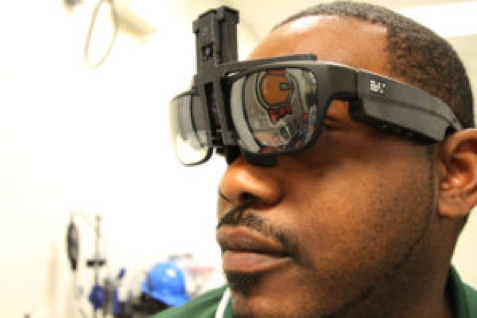
With smartwatches, glasses, and headsets already captivating users around the world, it’s no surprise that the next evolution of wearable technology could be used by first responders at the scene of an accident or by soldiers on a battlefield. The Integrated Display and Environmental Awareness System (IDEAS) is an interactive optical computer that works for smart glasses.

It has a transparent display, so users have an unobstructed view even during video conferences or while visualizing environmental data.

And while the IDEAS prototype is an innovative solution to the challenges of in-space missions, it won’t just benefit astronauts – this technology can be applied to countless fields here on Earth.
2. Every breath they take: life support technologies
Before astronauts can venture to Mars and beyond, we need to significantly upgrade our life support systems. The Next Generation Life Support project is developing technologies to allow astronauts to safely carry out longer duration missions beyond low-Earth orbit.

The Variable Oxygen Regulator will improve the control of space suit pressure, with features for preventing decompression sickness. The Rapid Cycle Amine technology will remove carbon dioxide and humidity and greatly improve upon today’s current complex system.

3. 3-D printing (for more than just pizza)
New Advanced Manufacturing Technologies (AMT), such as 3-D printing, can help us build rocket parts more quickly and aid in building habitats on other planets.

These manufacturing initiatives will result in innovative, cost-efficient solutions to many of our planetary missions. Back in 2014, the International Space Station’s 3-D printer manufactured the first 3-D printed object in space, paving the way to future long-term space expeditions.

The object, a printhead faceplate, is engraved with names of the organizations that collaborated on this space station technology demonstration: NASA and Made In Space, Inc., the space manufacturing company that worked with us to design, build and test the 3-D printer.

4. Spacecraft landing gear
Large spacecraft entering the atmosphere of Mars will be traveling over five times the speed of sound, exposing the craft to extreme heat and drag forces. The Hypersonic Inflatable Aerodynamic Decelerator (HIAD) is designed to protect spacecraft from this environment with an inflatable structure that helps slow a craft for landing.

To get astronauts and other heavy loads to the surface safely, these components must be very strong. The inflatable consists of a material 15 times stronger than steel, while the thermal protection system can withstand temperatures over 1600°C.
5. From heat shield technology to firefighter shelters

For the Convective Heating Improvement for Emergency Fire Shelters (CHIEFS) project, we partnered with the U.S. Forest Service to develop safer, more effective emergency fire shelters for wild land firefighters.

Using existing technology for flexible spacecraft heat shields like HIAD, we are building and testing new fire shelters composed of stacks of durable, insulated materials that could help protect the lives of firefighters.

6. Robots and rovers
Real life is looking a bit more like science fiction as Human Robotics Systems are becoming highly complex. They are amplifying human productivity and reducing mission risk by improving the effectiveness of human-robot teams.

Our humanoid assistant Robonaut is currently aboard the International Space Station helping astronauts perform tasks.

A fleet of robotic spacecraft and rovers already on and around Mars is dramatically increasing our knowledge and paving the way for future human explorers. The Mars Science Laboratory Curiosity rover measured radiation on the way to Mars and is sending back data from the surface.

This data will help us plan how to protect the astronauts who will explore Mars.

Future missions like the Mars 2020 rover, seeking signs of past life, will demonstrate new technologies that could help astronauts survive on the Red Planet.

7. Robotic repairs
Currently, a satellite that is even partially damaged cannot be fixed in orbit. Instead, it must be disposed of, which is a lot of potential science lost.

Satellite Servicing technologies would make it possible to repair, upgrade, and even assemble spacecraft in orbit using robotics.

This can extend the lifespan of a mission, and also enable deeper space exploration.

Restore-L, set to launch in 2020, is a mission that will demonstrate the ability to grab and refuel a satellite.
8. Low-cost spacecraft avionics controllers
Small satellites, or smallsats, are quickly becoming useful tools for both scientists and industry. However, the high cost of spacecraft avionics—the systems that guide and control the craft—often limits how and when smallsats can be sent into orbit by tagging along as payloads on larger launches.

Using Affordable Vehicle Avionics (AVA) technology, we could launch many more small satellites using an inexpensive avionics controller. This device is smaller than a stack of six CD cases and weighs less than two pounds!
9. Making glass from metal
After a JPL research team of modern-day alchemists set about mixing their own alloys, they discovered that a glass made of metal had the wear resistance of a ceramic, was twice as strong as titanium, and could withstand the extreme cold of planetary surfaces, with temperatures below -150 degrees Fahrenheit.

Bulk Metallic Glass (BMG) gears would enable mechanisms to function without wasting energy on heaters. Most machines need to maintain a warmer temperature to run smoothly, which expends precious fuel and decreases the mission’s science return.

By developing gearboxes made of BMG alloys, we can extend the life of a spacecraft and learn more about the far reaches of our solar system than ever before. Plus, given their extremely high melting points, metallic glasses can be cheaply manufactured into parts by injection molding, just like plastics.
10. Lighter, cheaper, safer spacecraft fuel tanks
Cryogenic propellant tanks are essential for holding fuel for launch vehicles like our Space Launch System—the world’s most powerful rocket. But the current method for building these tanks is costly and time-consuming, involving almost a mile of welded parts.

Advanced Near Net Shape Technology, part of our Advanced Manufacturing Technologies, is an innovative manufacturing process for constructing cryotanks, using cylinders that only have welds in one area.

This makes the tank lighter, cheaper, and safer for astronauts, as there are fewer potentially defective welds.
Follow us on Tumblr for your regular dose of space: http://nasa.tumblr.com
Historic Milestone in Space Flight Technology
Today, March 30, 2017, marks a significant and critical step in making affordable space travel more possible than ever.
Last April, the whole scientific community worldwide was watching as Elon Musk’s SpaceX successfully launched and landed the Falcon 9 rocket booster, proving for the first time in space flight history that it was possible to save and collect rockets after being launched into space. This March, SpaceX aims to up its standards by relaunching and re-landing the same rocket booster, which will deliver a communications satellite into orbit for a Luxembourg-based telecommunications company.
Why is this important? Simply put, rocket boosters are the most expensive part to build for any type of rocket. While SpaceX claims to have the most affordable rocket launches in the world, solidifying the concept of 100% reusable rocket boosters can save space programs $18 million per launch and open more doors for cost-effective commercial space travel.
If 100% reusable rocket boosters become a reality, the cost of launching rockets, experiments, and people into space can be significantly lowered to the point where non-scientific commercial space travel can be a common occurrence.
I can only wonder, then, how much and how far this development will impact not only the space industry, but the whole world itself. If this pushes through, there can be few excuses, then, for not recognizing the potential in looking beyond our own orbit and planet. With incredible scientific progress and discoveries happening almost every day, I think it’s only a matter of time before everyone sets their sights on the stars and starts pushing for interstellar travel.
We are no longer limited to our own solar system, and the possibilities that come with recognizing and answering to that are as unfathomable as space itself.
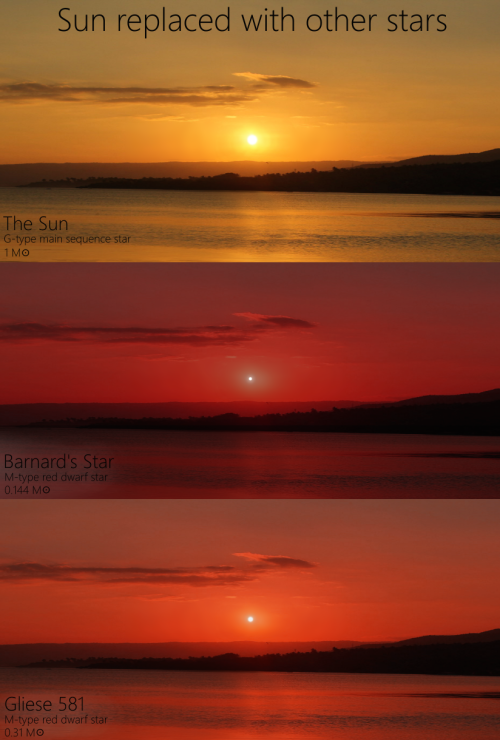
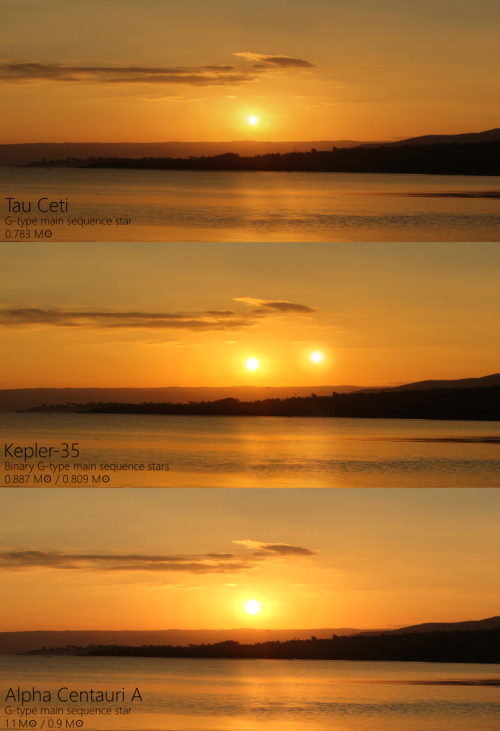
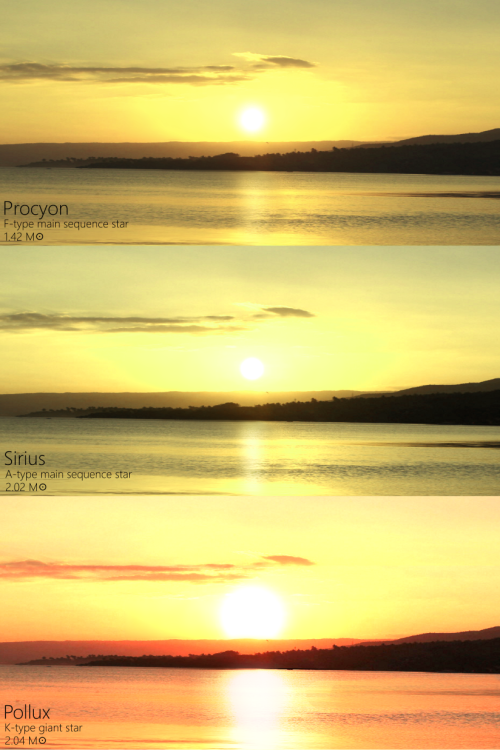
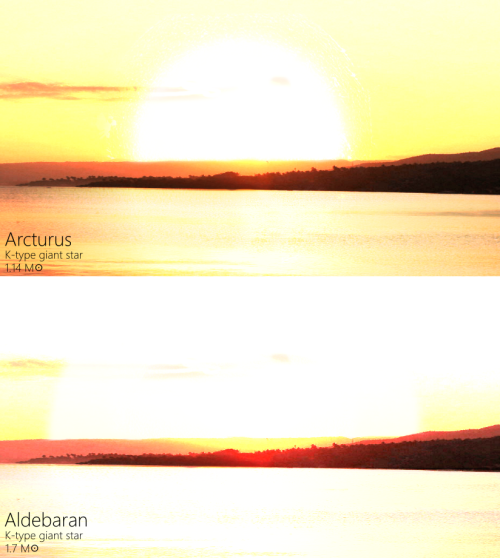
The Sun replaced with other Stars
This visualization shows how the sunset could look like to a human observer if our Sun was replaced by some of the other stars in our galaxy with different sizes and magnitudes, namely Barnard’s Star, Gliese 581, Tau Ceti, Kepler-23, Alpha Centauri A, Procyon, Sirius, Pollux, Arcturus and Aldebaran.
It is just a concept, as liquid water and the Earth as we know it could not exist in the vicinity of the most stars in this graphic. Visualizations are based on the absolute brightness, spectral class and the radius of each star.
by Martin Vargic

Absolutely love this shot from the extremely talented Nicholas Buer. Reminds me of this awe inspiring quote from physicist Brian Greene about the challenge humanity faces to understand the cosmos:
“We all love a good story. We all love a tantalizing mystery. We all love the underdog pressing onward against seemingly insurmountable odds. We all, in one form or another, are trying to make sense of the world around us. And all of these elements lie at the core of modern physics. The story is among the grandest – the unfolding of the entire universe; the mystery is among the toughest – finding out how the cosmos came to be; the odds are among the most daunting – bipeds, newly arrived by cosmic time scales trying to reveal the secrets of the ages; and the quest is among the deepest – the search for fundamental laws to explain all we see and beyond, from the tiniest particles to the most distant galaxies.” — Brian Greene
Meet Our 7 Newest Planetary Neighbors
On Wednesday, February 22, NASA took the whole world by storm when they announced the incredible discovery of 7 Earth-sized exoplanets – all of which could potentially have the right conditions for life to exist!
While there has been a relatively continuous stream of newly found exoplanets in the past years, this exoplanet system, named TRAPPIST-1 for the Chile-based telescope that first discovered the planets back in May, is particularly special because of three main reasons:
1.) They are considered relatively close (40 light years/235 trillion miles) to Earth.
2.) They are the first known system of Earth-sized planets that orbit a single parent star, with 3 planets located in the “Goldilocks zone”, the astrophysical orbit that has just the right conditions for allowing liquid water, and by extension, life, to exist. While all 7 could have liquid water, these 3 have the highest chances.
3.) Their parent star, an ultra-cool dwarf, has temperatures so low that liquid water can exist on the planets closest to it; what’s more, the planets are so incredibly close to their parent star – all 7 are closer to their parent star than Mercury is to our own Sun – that someone standing on the surface of each planet could potentially see the physical features of the other planets.
The implications of this find is mind-blowing: at the moment, Earth is the only planet we know that exists with liquid water in our solar system’s Goldilocks zone. We have no other suitable planet we can use for comparison, which is why the search for life in outer space can seem futile. But this discovery of 7 whole Earth-sized planets with the right conditions for water and life to flourish sparks the age-old question into overdrive – are we alone in the universe or not?
Earth is no longer the potentially only life-sustaining planet; we have 7 exoplanets, 3 in the Goldilocks zone, that can harbor water and life. That just blows my mind, and while I have often lamented in the past that I was born too late for traveling the world and too early for exploring space, I am grateful to be alive in this time of immense space-science discovery.
But what next? We’ve discovered this new system, what are we going to do about it? According to NASA, a new telescope called the James Webb Space Telescope will be launched in 2018. Equipped with state-of-the-art technological capabilities such as increased sensitivity sensors, it will be able to detect chemical signals present in a planet’s atmosphere such as methane, oxygen, and water. And hopefully, it will tell us more about our 7 new neighbors – and what could be on them.
A Personal Update
Hello everyone! This is just a quick behind-the-blog update from me.
I’ve been applying to NASA internships for the past three months, and I’m sad to say that I was not chosen for any of them.
I must admit it broke my heart a little bit to see the positions I applied for fill up with no offer extended to me. I really thought I had a good shot at a few of them this time around. I really thought I had a chance.
I’m writing this because I want everyone to know that is natural to feel frustrated and disappointed, and that whatever setback you may encounter is not the end of the world. Just as there are countless stars in the night sky, there are just as many opportunities still waiting for you to find them.
Yes, my heart is heavy from this, but I know I’ll bounce right back. Rejection is a part of life, after all, and no one ever made it to the stars after giving up because of a few rejections.
I’m going to keep moving forward, with my eyes on the stars, doing what I love to do, and I know I’ll get where I want to be someday.
Until then, ad astra!

A Quick Q&A
Ever my first post, I’ve had some great comments and questions from people who’ve stopped by my blog, and I’m going to respond to them all in this post to keep things organized!
---
Q1: In reference to the Emirates’ plans to build a Mars city by the end of the century - do you think they can do it? (question by krrizal)
A: I definitely think anything is possible. With the current rate of technological advancements and rise of interest in space exploration globally, I think there is a lot of support for those who want to go space - and more specifically Mars. Really, there has never been a better time for space to take the forefront of global topics. If Emirates stays on track with their plans, I believe they can build a city on Mars.
---
Q2: cute theme! where did you get it from? (question anonymous)
A: Hello! The theme is made by this wonderful person, I just added my own code to it for editing and personalizing purposes.
---
Q3: lol high 5 from UCF! (comment made anonymous)
A: Go Knights! :D
---
Q4: Do you have any experience working in space?
A: I wish! I am doing undergraduate research right now in the field of environmental engineering, since I also want to go into sustainable energy. I’m waiting on internship responses from NASA, so fingers crossed! My dream is to do astrobiology research in space and sustainable urban development down on Earth.
---
Thank you everyone for your questions and comments! Please feel free to stop by my ask box at any time.

-
 saphicspacesociety18 reblogged this · 1 year ago
saphicspacesociety18 reblogged this · 1 year ago -
 maguixinha0202-blog reblogged this · 3 years ago
maguixinha0202-blog reblogged this · 3 years ago -
 maguixinha0202-blog liked this · 3 years ago
maguixinha0202-blog liked this · 3 years ago -
 acivilzedhuman reblogged this · 3 years ago
acivilzedhuman reblogged this · 3 years ago -
 byronichero-ine liked this · 3 years ago
byronichero-ine liked this · 3 years ago -
 atomicgod reblogged this · 3 years ago
atomicgod reblogged this · 3 years ago -
 thereverendjoey1959 reblogged this · 3 years ago
thereverendjoey1959 reblogged this · 3 years ago -
 untitled27443 liked this · 3 years ago
untitled27443 liked this · 3 years ago -
 cheekybug2 liked this · 3 years ago
cheekybug2 liked this · 3 years ago -
 damnjenrn liked this · 3 years ago
damnjenrn liked this · 3 years ago -
 aerostotl liked this · 3 years ago
aerostotl liked this · 3 years ago -
 conanesque reblogged this · 3 years ago
conanesque reblogged this · 3 years ago -
 residenceme liked this · 3 years ago
residenceme liked this · 3 years ago -
 poorrichardjr liked this · 3 years ago
poorrichardjr liked this · 3 years ago -
 godutchman liked this · 3 years ago
godutchman liked this · 3 years ago -
 robert-koeller-artwork liked this · 3 years ago
robert-koeller-artwork liked this · 3 years ago -
 celynwmn1689 liked this · 3 years ago
celynwmn1689 liked this · 3 years ago -
 allessio77 liked this · 3 years ago
allessio77 liked this · 3 years ago -
 blogurbane liked this · 3 years ago
blogurbane liked this · 3 years ago -
 aspergoth liked this · 3 years ago
aspergoth liked this · 3 years ago -
 religionispointless liked this · 3 years ago
religionispointless liked this · 3 years ago -
 jilli1205 reblogged this · 3 years ago
jilli1205 reblogged this · 3 years ago -
 jilli1205 liked this · 3 years ago
jilli1205 liked this · 3 years ago -
 prettymuchperfect79 liked this · 3 years ago
prettymuchperfect79 liked this · 3 years ago -
 doc-did liked this · 3 years ago
doc-did liked this · 3 years ago -
 tikihutlounge reblogged this · 3 years ago
tikihutlounge reblogged this · 3 years ago -
 tikihutlounge liked this · 3 years ago
tikihutlounge liked this · 3 years ago -
 strongagnostic reblogged this · 3 years ago
strongagnostic reblogged this · 3 years ago
CONSTELLATION: (noun) Group of stars that form a recognizable pattern to which a mythological or earth-based name is assigned Pattern of stars whose name or is associated with different stories and meanings Story told by stars connected across the infinite night sky, overlapping with countless other stories that have unfolded from ancient supernovas, whose imaginary lines urge our eyes up from the chaos of the world around us to the unknown vastness in which we are but a speck of dust -------- Hi! I’m a starry-eyed astrogeek named Dianne who loves absolutely everything that has to do with the stars and outer space. When I’m not studying or preparing to take over NASA one day, you can find me trying to stargaze despite city lights or happily planning my next road trip.
35 posts